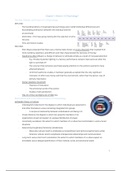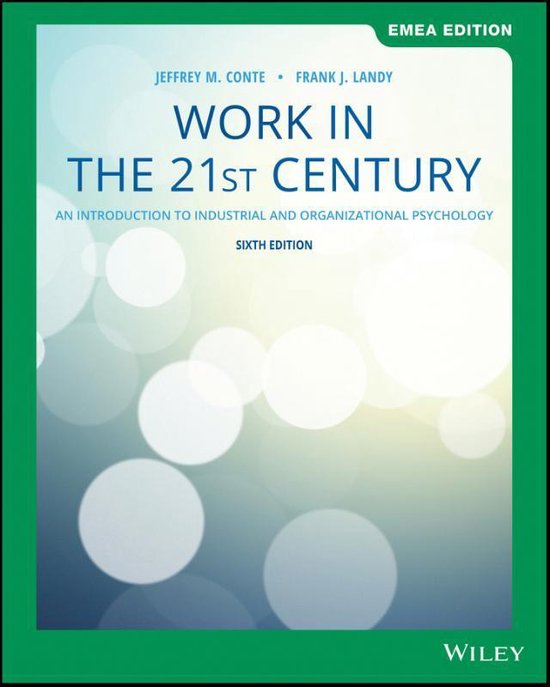Chapter 1: What Is I-O Psychology?
The Past, Present, and Future of I-O Psychology
1876-1930:
- The founding fathers of organizational psychology were Cattell (individual differences) and
Munsterberg (interaction between the individual and the
environment)
- World War I: first mass group testing (for the selection of army
recruits)
- Time and motion studies
1930-1964:
- Elton Mayo proposed that there was a mental state known as revery obsession that resulted from
mind-numbing, repetitive, and difficult work that characterized the factories of the day
- Hawthorne effect (Mayo): a change in behavior or attitudes simply as a result of increased attention
- E.g., introducing better lighting in a factory; performance remains improved even after the
light is switched off
- The very fact that someone was finally paying attention to the workers seemed to have
affected behavior
- Until the Hawthorne studies, it had been generally accepted that the only significant
motivator of effort was money and that the environment, rather than the person, was of
primary importance
- Human relations movement
- Theories of motivation
- The emotional world of the worker
- Studies of job satisfaction
- Title VII of the Civil Rights Act of 1964 few
Multicultural and Cross-Cultural Issues in I-O Psychology
Hofstede’s theory of culture:
- Individualism/collectivism: the degree to which individuals are expected to
look after themselves versus remaining integrated into groups
- A reciprocal relationship between individualism and being rich
- Power distance: the degree to which less powerful members of an
organization accept and expect an unequal distribution of power
- Uncertainty avoidance: the extent to which members of a culture feel comfortable in unstructured
situations
- Masculinity (toughness)/femininity (tenderness)
- Masculine cultures tend to emphasize accomplishment and technical performance while
feminine cultures tend to emphasize interpersonal relationships and communication
- Long-term versus short-term orientation: the extent to which members of a culture expect an
immediate versus delayed gratification of their material, social, and emotional needs
1
, Chapter 4: Job Analysis and Performance
A Basic Model of Performance
Performance: actions and behaviors
- Maximum performance: the level of performance in a given domain that one can produce on demand
for a short period of time if one chooses to exert maximum effort
- Typical performance: day-to-day performance
- A moderate (.42) correlation between maximum and typical performance → the two constructs are
separate
- A correlation of 1 would imply that maximum performance = typical performance (which is
not the case!)
- Whether one engages in maximum or typical performance depends on several moderators (i.e., factors
that influence the correlation between X and Y); discussed in the article by Baus
Effectiveness: the consequences of your actions (i.e., the evaluation of the results of your performance)
- The variation in a measure of effectiveness is often controlled by factors beyond the actions of an
individual (e.g., the quality of equipment)
Productivity: the ratio of effectiveness (output) to cost of achieving that level of effectiveness (input).
Campbell’s model of job performance proposes 3 direct determinants of job
performance:
- Declarative knowledge (DK): knowledge to understand what you’re
doing
- Procedural knowledge and skill (PKS): knowing how to perform a task
- Motivation (M)
- Other variables (e.g., ability, personality, and training) have an i ndirect effect on performance
If one of the elements is 0, the outcome will also be 0
- E.g., if you do not have any motivation but you do
know what you need to do (and vice versa) → you will
fail
DK, PKS, and M are determinants of performance. Campbell’s
research identified eight basic performance components (see complete model), some or all of which can be
found in every job.
The ultimate (theoretical) criterion is the ideal measure of all relevant aspects of job performance. The a ctual
criterion is the actual measure of job performance obtained
- In the ideal world, the theoretical criterion = the observed criterion
- The overlap between the theoretical criterion and the observed criterion
represents the criterion relevance
Differences between ultimate criterion and actual criterion represent imperfections in
measurement, which include:
- Criterion deficiency: when the actual criterion is missing information that is part of the behavior one is
trying to measure
2
, - Criterion contamination: when the actual criterion includes information unrelated to the behavior one
is trying to measure
Extensions of the Basic Performance Model
The relationships between input (performance) and output (effectiveness) is influenced
by randomness (i.e., factors beyond your control).
Types of performance (extended model):
- Task performance (TP): things that are expected from you
- I.e., what’s part of your job description
- Best determined by cognitive ability
- Organizational citizenship behavior (OCB): going beyond what is expected from you
- Altruism: helpful behaviors directed toward individuals or groups within the organization
- Generalized compliance: behavior that is helpful to the broader organization
- E.g., helping the organization with new procedures or upholding company rules
- Basically, it’s helping the organization develop further
- Largely a social phenomenon
- OCB best predicted by personality dimensions, particularly conscientiousness
- Individuals high in C are much more likely to persist with extra effort in completing
their work and following organizational rules and procedures
Counterproductive work behaviors (CPB): voluntary behavior violating significant organizational norms and
threatening the organization, its members, or both
- Interpersonal deviance: aimed towards a person
- Organizational deviance: aimed towards the organization
- Common counterproductive behaviors include:
- Dishonesty: employee theft or dishonest communication
- Absenteeism: failure to report for or remain at work as
scheduled
- Sabotage: acts that damage, disrupt, or subvert the organization’s operations
- Individuals who feel useless (or think their tasks are worthless) are most likely to engage in CPB
Adaptive performance: beneficial due to changing nature of work
- Adaptive = changing together with the changing world
- Changing technologies alter work tasks
- Mergers, downsizing, & corporate restructuring require employers to learn new skills
- Globalization requires individuals to work in different cultures
- Emotional stability and ambition positively related to adaptive performance
Expert performance: performance exhibited by those who have practiced for at least 10 years and have spent
an average of 4 hours/day on deliberate practice
- Deliberate practice refers to individualized training on tasks selected by a qualified teacher
- Other factors that may contribute are starting age and general intelligence
Types of performance measures:
- Objective performance measures: the quantitative count of the results of your work
3
, - E.g., how many lamps you produce in a day
- Judgemental measures: the evaluation of the effectiveness of an individual’s work
- E..g, how good is the quality of the lamps
- Rated by an expert/superior
- Most likely to yield a reasonable estimate of individual behavior, because it permits the
evaluator to account for influences outside the control of the individual worker
- E.g., if a sales rep is assigned to a difficult sales territory, the manager is aware of that
handicap and can adjust the judgment accordingly
- If the manager was required to use an objective measure of sales success,
the employee would be at a considerable disadvantage
- Personnel measures: typically kept in a personnel file (e.g., absences, accidents, rate of advancement)
Job Analysis: Fundamental Properties and Practices
Job analysis: a process that determines the ‘essence’ of a collection of tasks falling within the scope of a
particular job title. The uses of job analysis information:
- Job description
- Recruiting
- Selection
- Training
- Compensation
- Promotion/job assignment
- Job design
- Workforce reduction/restructuring
- Criterion development
- Performance evaluation
- Litigation
Two approaches:
- Task-oriented job analysis: begins with the statement of actual tasks and what is accomplished with
those tasks
- I.e., what has to be done
- Sample statement: operates Bombardier Snowcat, usually at night, to smooth out snow
rutted by skiers and snowboard riders, and new snow that has fallen
- Worker-oriented job analysis: focuses on the attributes of the worker necessary to accomplish the
tasks
- I.e., the person who can do it
- Sample statement: evaluates terrain, snow depth, and snow condition and chooses the
correct setting for the depth of the snow cut, as well as the number of passes necessary on a
given ski slope
Regardless of which approach is taken, the next step in the job
analysis is to identify the attributes (the KSAOs) that an incumbent
4






